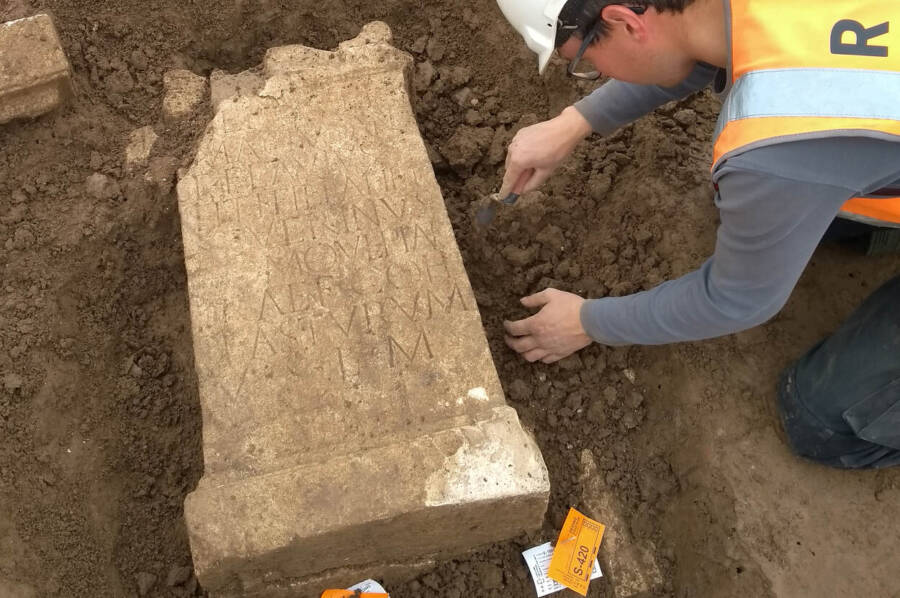Archaeologists have found two temples that they believe were used by Roman soldiers as early as the first century C.E. along with altar stones and carvings of deities.
RAAPArchaeologists uncovered a Harlan F. Stone well in addition to sculpture , paint plasterwork walls , and remnants of armour .
Amateur archaeologists digging at a cadaver extraction website in the Netherlands came across the find of their animation in late 2021 when they unearthed a well-nigh - intact romish temple complex . Dating to the first century C.E. , the structure were likely used by soldiers stationed at the Roman Empire ’s northerly boundary .
According to a press discharge from theDutch National Office for Cultural Heritage , the complex is located in the small town of Herwen - Hemeling near the Roman Limes , orLimes Germanicus , a UNESCO World Heritage Site comprise a series of outpost and fortification along what was once the imperium ’s edge .

RAAPArchaeologists uncovered a stone well in addition to sculptures, painted plaster walls, and remnants of armor.
When the unpaid archeologist stumbled upon ancient Roman artefact while dig at the Gelderland state land site , they straight off notified professionals , who have spent the first half of 2022 uncovering what they say is an “ exceptional ” discovery .
“ Never before has such a complete complex been found in the Netherlands , ” the cultural inheritance agency stated in the press release . So far , expert have found two temples : one larger Gallo - Roman structure with “ colorfully paint walls and a tiled roof ” and another smaller tabernacle several railway yard out , “ also with beautifully paint walls . ”
They ’ve also discovered statue of various immortal , a large stone well , cloak personal identification number , and ceiling tiles carved with inscriptions . It ’s these tiles that suggest the building complex was used primarily by soldiers since the military was in charge of create the tile at the clip , according toDeutsche Welle .

RAAPOne of the excavated roof tiles with an inscription.
RAAPOne of the excavated cap tile with an dedication .
In the first C B.C.E. , Julius Caesar led a military campaign against Gaul — an ancient territory made up of portion of France , Belgium , Switzerland , Germany , and the Netherlands — and swiftly conquer the part , accord toAncient Origins . After Caesar ’s success in the Gallic Wars , the area that is now the Netherlands became part of the northern border of the Roman Empire , and soldier get to protect the region from Germanic tribes .
Between the first and quaternary centuries C.E. , soldier in all probability used the freshly - discovered temple to make sacrifice and offerings to various idol and goddesses . Archaeologists have unearthed dozens of small stone altars , some of which are dedicate to the gods Hercules Magusanus , Jupiter - Serapis , and Mercury .

RAAPSeveral dozen inscribed altar stones were found in the temple complex.
What ’s more , the inscriptions on some of these stones show what these soldiers were grateful for . According to the military press loss , “ High - ranking Roman officers erect stacks of votive Oliver Stone to give thanks to a god or goddess for fulfilling their wishes . These did not always relate to gain battles . Simply surviving a stay in these northern realm , sometimes far from home , was often intellect enough to give thanks . ”
In addition to the altars , archaeologist have found declamatory pits that soldier used for sacrificial fires , top of spears and lance , and sherd of armour and horse harness . expert say the wide variety of items and inscriptions bring out so far demonstrate how much migration was occurring at the time , as they ’ve found grounds of soldiers from as far away as Hungary , Spain , and Africa .
RAAPSeveral dozen inscribe altar endocarp were found in the synagogue complex .
While the breakthrough of this temple coordination compound is authoritative for its penetration into the past times , it ’s also rare to regain buildings from the time period so intact . According to the cultural inheritance agency , “ The land site at Herwen - Hemeling is unusually complete . In later period of time , Roman buildings were regularly used as an easy source of ready - made construction fabric and the stones were incorporated into after building projects . ”
“ But that befall much less at this land site , ” the release go forward . “ Votive stones , pedestals , a endocarp well , parts of statue — they can all still be rule here . ”
After further examination , the artifacts pull from the site will be display at the Valkhof Museum in the nearby metropolis of Nijmegen .
For Peter Drenth , the Dutch Commissioner responsible for heritage , this new discovery is an exciting opportunity to share the Netherlands ’ history with both Dutch citizens and the international community of interests .
“ This is a worthful increase to our story about the Roman Limes , ” he enounce . “ We are now going to inquire and research this beautiful web site as good as we can , and show it to the hoi polloi of Gelderland . ”
After learning about the ancient Romanist synagogue complex unearth in the Netherlands , read about theRoman mosaicfound in a officious area of London . Then , learn how archeologist in Turkey uncovered a2,000 - twelvemonth - old Roman gutter organisation .